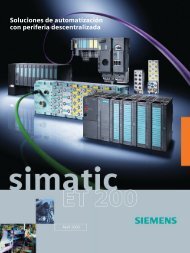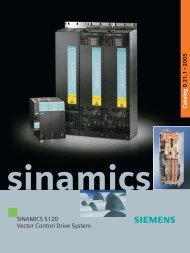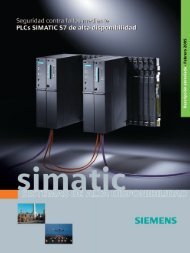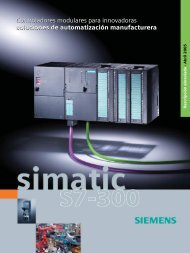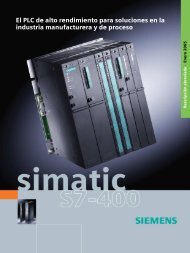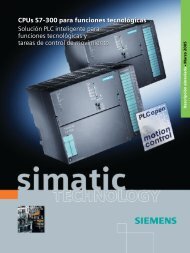Power supplies SITOP power LOGO!Power Catalog K T 10.1 2004
Power supplies SITOP power LOGO!Power Catalog K T 10.1 2004
Power supplies SITOP power LOGO!Power Catalog K T 10.1 2004
You also want an ePaper? Increase the reach of your titles
YUMPU automatically turns print PDFs into web optimized ePapers that Google loves.
Technical information and configuration<br />
<strong>Power</strong> <strong>supplies</strong> general<br />
■ <strong>Power</strong> <strong>supplies</strong><br />
In plant construction or mechanical engineering, or in any other<br />
situations in which electrical controls are used, a safe and reliable<br />
<strong>power</strong> supply is needed to supply the process with <strong>power</strong>.<br />
The functional reliability of electronic controls and therefore the<br />
reliable operation of automated installations is extremely closely<br />
linked to the resistance of the load <strong>power</strong> supply to failure. Final<br />
control elements as well as input and output modules will only<br />
respond to command signals if the <strong>power</strong> supply is operating<br />
reliably.<br />
In addition to general requirements such as reliability, particular<br />
demands are placed on the electromagnetic compatibility<br />
(EMC) of the <strong>power</strong> supply with reference to the tolerance range<br />
of the output voltage as well as its ripple.<br />
Important factors that determine problem-free implementation<br />
are, in particular:<br />
• An input current with a low harmonic content<br />
• Low emitted interference and<br />
• Adequate immunity (noise immunity) to interference<br />
EMC<br />
Emission (emitted interference)<br />
Immunity (immunity to interference)<br />
Certain disturbing phenomena<br />
Types of interference<br />
Interference caused by television<br />
and radio reception<br />
Interference coupling with data<br />
lines or <strong>power</strong> supply cables<br />
Faults on the <strong>power</strong> cable due to<br />
switching non-resistive loads<br />
such as motors or contactors<br />
Static discharge due to lightning<br />
strikes<br />
Electrostatic discharge through<br />
the human body<br />
Conducted noise induced by<br />
radio frequencies<br />
■ General notes on DC <strong>power</strong> <strong>supplies</strong><br />
The DC <strong>power</strong> supply is a static device with one or more inputs<br />
and one or more outputs that converts a system of AC voltage<br />
and AC current and/or DC voltage and DC current to a system<br />
with different values of DC voltage and DC current by means of<br />
electromagnetic induction for the purpose of transmitting electrical<br />
energy.<br />
The type of construction of a DC <strong>power</strong> supply is usually decided<br />
by its intended use.<br />
■ Unstabilized DC <strong>power</strong> <strong>supplies</strong><br />
The AC mains voltage is transformed using 50 Hz/60 Hz safety<br />
transformers to a protective extra-low voltage and smoothed<br />
with down-circuit rectification and capacitor filtering.<br />
Line isolation Rectification Filtering<br />
In the case of unstabilized DC <strong>power</strong> <strong>supplies</strong>, the DC output<br />
voltage is not stabilized at a specific value, but the value is<br />
varied in accordance with the variation in (mains) input voltage<br />
and the loading.<br />
The ripple is in the Volt range and is dependent on the loading.<br />
The value for the ripple is usually specified as a percentage of<br />
the DC output voltage level. Unstabilized DC <strong>power</strong> <strong>supplies</strong><br />
are characterized by their rugged, uncomplicated design that is<br />
limited to the important factors and focussed on a long service<br />
life.<br />
50 Hz<br />
~<br />
+<br />
V out<br />
G_KT01_EN_00067<br />
Block diagram of an unstabilized <strong>power</strong> supply<br />
■ Stabilized DC <strong>power</strong> <strong>supplies</strong><br />
14<br />
Stabilized DC <strong>power</strong> <strong>supplies</strong> have electronic regulation circuits<br />
that maintain the DC voltage at the output at a specific value with<br />
as little variation as possible. Effects such as variation in input<br />
voltage or changes in load at the output are electrically compensated<br />
in the specified function area.<br />
The ripple in the output voltage for stabilized DC <strong>power</strong> <strong>supplies</strong><br />
lies in the millivolt range and is mainly dependent on the loading<br />
at the outputs.<br />
Stabilized DC <strong>power</strong> <strong>supplies</strong> can be implemented on different<br />
functional principles. The most common types of circuit are:<br />
• Linear stabilized <strong>power</strong> <strong>supplies</strong><br />
• Magnetic voltage stabilizer<br />
• Secondary pulsed switched-mode <strong>power</strong> <strong>supplies</strong><br />
• Primary pulsed switched-mode <strong>power</strong> <strong>supplies</strong><br />
The most suitable principle for a particular application case will<br />
depend mainly on the application. The objective is to generate a<br />
DC voltage to supply the specific load as inexpensively and as<br />
accurately as possible.<br />
14/2<br />
Siemens KT<strong>10.1</strong> · <strong>2004</strong>




